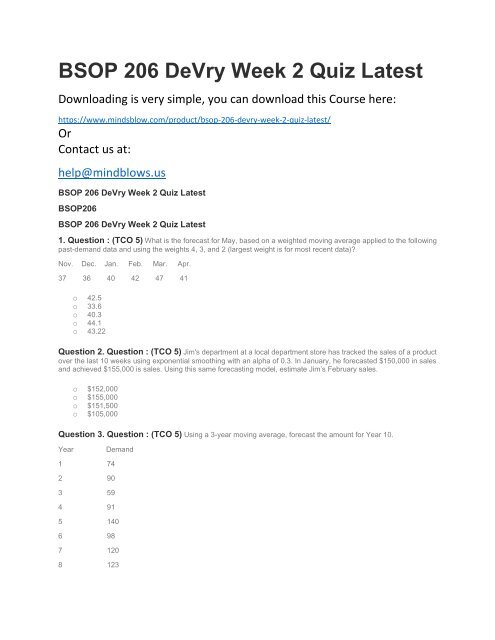BSOP 206 DeVry Week 2 Quiz Latest
Create successful ePaper yourself
Turn your PDF publications into a flip-book with our unique Google optimized e-Paper software.
<strong>BSOP</strong> <strong>206</strong> <strong>DeVry</strong> <strong>Week</strong> 2 <strong>Quiz</strong> <strong>Latest</strong><br />
Downloading is very simple, you can download this Course here:<br />
https://www.mindsblow.com/product/bsop-<strong>206</strong>-devry-week-2-quiz-latest/<br />
Or<br />
Contact us at:<br />
help@mindblows.us<br />
<strong>BSOP</strong> <strong>206</strong> <strong>DeVry</strong> <strong>Week</strong> 2 <strong>Quiz</strong> <strong>Latest</strong><br />
<strong>BSOP</strong><strong>206</strong><br />
<strong>BSOP</strong> <strong>206</strong> <strong>DeVry</strong> <strong>Week</strong> 2 <strong>Quiz</strong> <strong>Latest</strong><br />
1. Question : (TCO 5) What is the forecast for May, based on a weighted moving average applied to the following<br />
past-demand data and using the weights 4, 3, and 2 (largest weight is for most recent data)?<br />
Nov. Dec. Jan. Feb. Mar. Apr.<br />
37 36 40 42 47 41<br />
o 42.5<br />
o 33.6<br />
o 40.3<br />
o 44.1<br />
o 43.22<br />
Question 2. Question : (TCO 5) Jim's department at a local department store has tracked the sales of a product<br />
over the last 10 weeks using exponential smoothing with an alpha of 0.3. In January, he forecasted $150,000 in sales<br />
and achieved $155,000 is sales. Using this same forecasting model, estimate Jim’s February sales.<br />
o $152,000<br />
o $155,000<br />
o $151,500<br />
o $105,000<br />
Question 3. Question : (TCO 5) Using a 3-year moving average, forecast the amount for Year 10.<br />
Year<br />
Demand<br />
1 74<br />
2 90<br />
3 59<br />
4 91<br />
5 140<br />
6 98<br />
7 120<br />
8 123
9 99<br />
o Year 10 = 122.87<br />
o Year 10 = 99.98<br />
o Year 10 = 110.67<br />
o Year 10 = 114<br />
Question 4. Question : (TCO 7) Which of the following helps operations managers focus on the trivial few and<br />
the critical many?<br />
o<br />
o<br />
o<br />
o<br />
o<br />
Value analysis<br />
Value engineering<br />
Financial analysis<br />
Product-by-value analysis<br />
None of the above<br />
Question 5. Question : (TCO 7) Which of the following moments of truth exemplifies the customer's standard<br />
expectations?<br />
o<br />
o<br />
o<br />
o<br />
Your advisor made you wait, even though you had an appointment.<br />
You had to visit once to reach your academic advisor.<br />
Your advisor was competent, helpful, and understanding.<br />
Your advisor failed to keep his or her appointment with you<br />
Question 6. Question : (TCO 7) Forecasts are usually classified by time horizon into three categories. What are<br />
they?<br />
o Short-range, medium-short, and long-range<br />
o Finance/accounting, marketing, and operations<br />
o Strategic, tactical, and operational<br />
o Exponential smoothing, regression, and time series<br />
o Long-range, medium-range, and short-range :<br />
Question 7. Question : (TCO 7) A product's life cycle is divided into four stages, which are _____.<br />
o<br />
o<br />
o<br />
o<br />
o<br />
introduction, growth, decline, and maturity<br />
introduction, growth, stability, and decline<br />
introduction, maturity, saturation, and decline<br />
introduction, growth, immaturity, and decline<br />
None of the above<br />
Question 8. Question : (TCO 7) The specific components inputted into the fourth house in the house of quality<br />
are satisfied by _____.<br />
o<br />
o<br />
o<br />
o<br />
the quality plan<br />
customer requirements<br />
design characteristics<br />
the production process<br />
Question 9. Question : (TCO 5) In time series, which of the following cannot be predicted?<br />
o<br />
o<br />
o<br />
o<br />
o<br />
Random variations “blips”<br />
Technological trends<br />
Seasonal fluctuations<br />
Regular fluctuations<br />
Large decreases in demand
Question 10. Question : (TCO 6) Which of these statements best describes computer-aided design (CAD)?<br />
o<br />
o<br />
o<br />
o<br />
It is the interactive use of computers to design a product and prepare engineering documentation.<br />
The use of special computer programs to direct and control manufacturing equipment.<br />
It is the ability to depict objects in three-dimensional form.<br />
It is a visual form of communication in which images substitute for the real thing.<br />
1. Question : (TCO 7) What is quality function deployment (QFD)? Provide an example of how it can be used.<br />
Question 2. Question : (TCO 7) What are the benefits to manufacturability and value engineering?<br />
Question 3. Question : (TCO 5) What are the benefits of quantitative and qualitative forecasting methods?<br />
Question 4. Question : (TCO 5) Which one of the four components of a time series is rarely forecast, and why<br />
is this?<br />
Question 5. Question : (TCO 6) What is a make-or-buy decision and why is it so important?

















